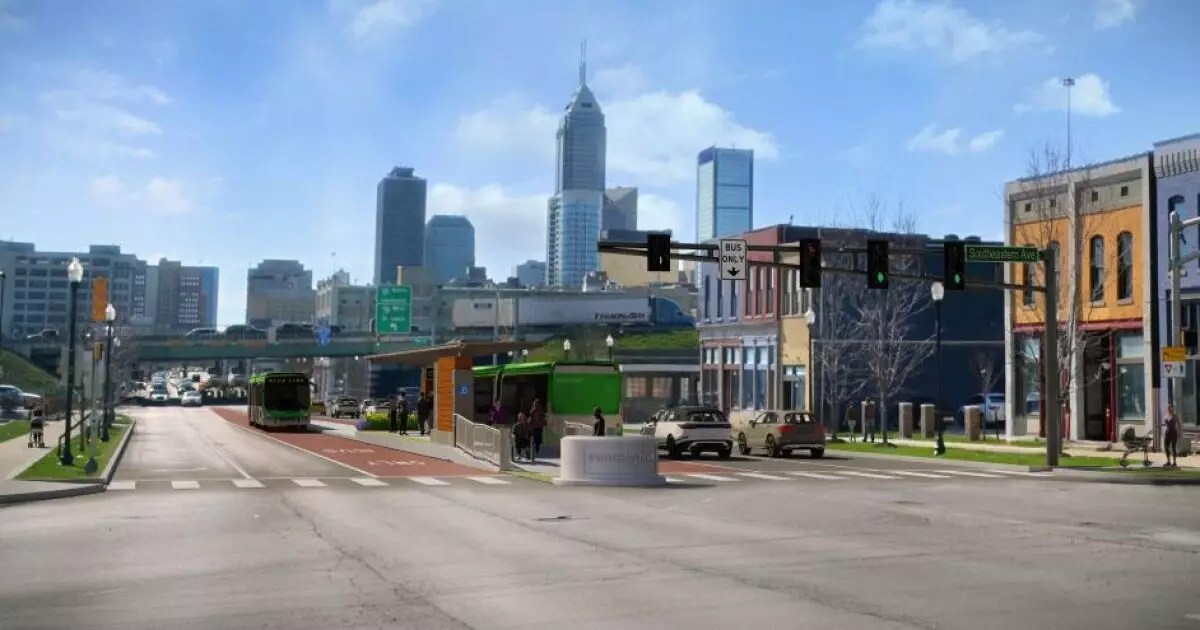Recent plans for a $125 million bond sale tied to the Indianapolis Public Transportation Corporation (IndyGo) have thrown the spotlight on the city’s public transit system, which is set to expand with the Blue Line Bus Rapid Transit (BRT) project. This expansion attempts to connect essential locations—from the Indianapolis International Airport to downtown and ultimately to Marion County’s eastern edge. Despite the AA-minus credit rating afforded by S&P Global Ratings, which presents a seemingly stable outlook, one must question whether merely increasing funding can genuinely address the myriad issues plaguing urban transit infrastructure.
Selling bonds for capital is a common mechanism to support public transit development; however, this structure is fundamentally flawed when it doesn’t engage with a broader strategy addressing long-term sustainability and efficiency. While the bonds promised funding for new bus stations and better service, the reality remains that the very essence of public transit in cities like Indianapolis—already burdened with underfunded legacy systems—is that they do not always become the nimble, effective services commuters desperately need.
The Illusion of Improvement: The Blue Line’s Challenges
The Blue Line project, characterized as a ‘fixed route service that emulates light rail,’ promises to bring efficiency to public transit. However, it raises essential questions about the viability of such projects when longer-term issues remain unaddressed. Will adding new stations and routes lead to improved service, or merely distract from deeper structural weaknesses within the transit framework? Historical data suggests that investment in public transit innovation doesn’t always translate into increased ridership. The burgeoning costs, paired with rising municipal yields amid market volatility, indicate that the financial backing may be at risk of overshadowing actual traffic improvements.
While the recent announcement of the project was celebrated, one cannot ignore the fact that IndyGo, facing issues such as reduced farebox recovery and a significant dip in ridership (down to 75% of pre-pandemic levels), should be focusing on rebuilding trust and service quality among commuters. Simply injecting funds into a system without addressing its effectiveness could become an endless cycle of spending with little return.
Sustainable Funding or Just A Band-Aid? The Local Income Tax Revenue Bond Scheme
The plan to finance these ambitious transit routes through local income tax revenue bonds is a double-edged sword. While this model potentially offers a continuous stream of financing, isolating funding through tax mechanisms risks placing unrealistic expectations on city residents. Such financial strategies often lead to decisions made in isolation and often sidestep the convolution of public sentiment towards taxation and spending.
Pledging income tax revenues to fund the 2025A bonds effectively places the burden on Marion County’s residents, many of whom face broader economic challenges, exacerbated by inflation and rising living costs. One can only wonder if this method of financing is genuinely a sustainable solution or simply a stopgap hastily crafted to appease immediate needs with scant consideration for long-term repercussions. Could IndyGo not instead focus on more prudent fiscal policies, like optimizing existing services or increasing fare recovery rates, rather than bank on perpetual taxpayer funding?
The Importance of a Holistic Approach Toward Transit Services
Creating a successful public transit system requires careful planning and ongoing evaluation, rather than merely rushing toward new funding avenues. IndyGo’s long-term debt of approximately $209.1 million post-bond sale speaks volumes about the overarching financial concerns that have permeated public infrastructure spending. Public transit services should not be treated as isolated projects that can thrive on sudden influxes of cash, but rather integrated components of a cohesive urban infrastructure strategy that factors in economic implications for the constituents it serves.
Solving the complex mosaic of public transit issues requires not just financial investments but also reevaluating how these systems are run. Columbus and Nashville have effectively altered their approach by prioritizing customer satisfaction and urban mobility studies that directly guide funding, policy-making, and service enhancements. Shall Indianapolis heed this advice and transform its transit philosophy, or will it continue to stumble along with underwhelming ridership, excessive spending, and half-hearted attempts at reform?
The time for a fundamental rethinking of public transit in Indianapolis is long overdue. The city must move beyond linear funding models and address the intertwined challenges of accessibility and efficiency within a distinctly clear framework for a more sustainable urban future. Without introspection and actionable strategies, the cycle of insufficient public services and overstressed funding will only perpetuate, leaving citizens standing at the bus stop, waiting in vain for change to arrive.


Leave a Reply